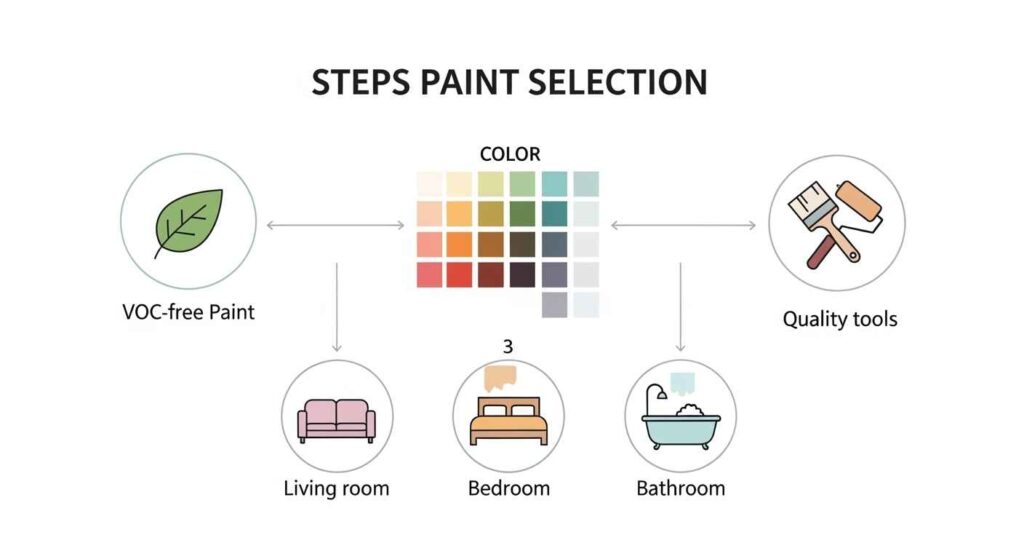Making your home healthier starts with the paint on your walls. Traditional paints release harmful chemicals into your air for days, weeks, and even months after application. The EPA notes that VOC effects are about two to five times higher indoors than outdoors, making paint choice crucial for your family’s health.
This guide covers everything you need to know about choosing safe, non-toxic paint that protects your family while delivering beautiful results.
What Makes Paint Eco-Friendly?
Eco-friendly paints differ from traditional options in several key ways. They contain little to no volatile organic compounds (VOCs) and avoid harmful chemicals like formaldehyde, benzene, and heavy metals.
Key features of eco-friendly paints:
- Zero or low VOC content (under 50g/L)
- No hazardous air pollutants (HAPs)
- Made from natural or recycled materials
- Biodegradable ingredients
- Minimal environmental impact during production
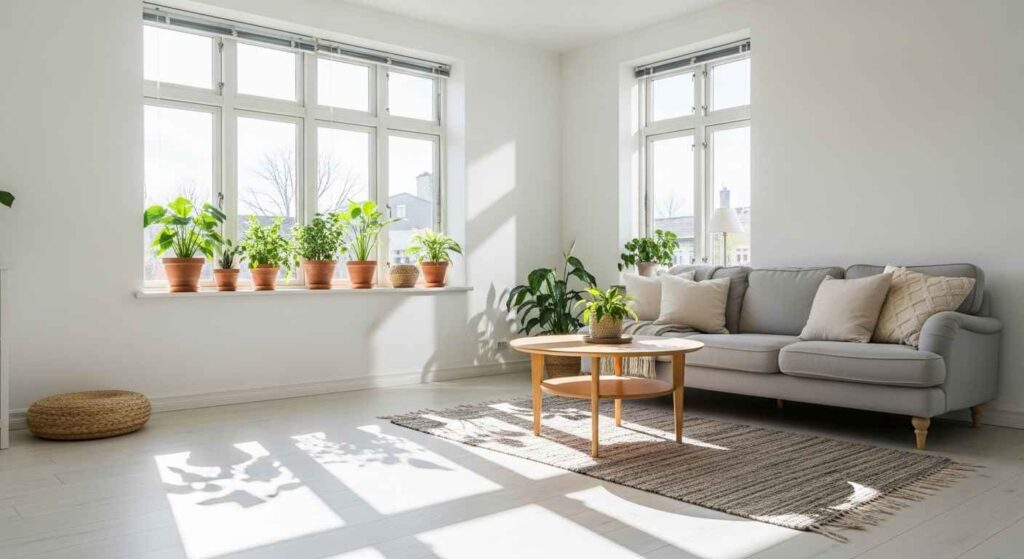
Why VOCs Matter in Your Home
VOCs are chemicals that turn into gas at room temperature. When paint contains VOCs, these gases escape into your home’s air supply. Common VOCs in traditional paint include:
- Formaldehyde
- Benzene
- Xylene
- Toluene
- Ethylene glycol
Health effects of VOC exposure:
- Headaches and dizziness
- Eye and throat irritation
- Respiratory problems
- Memory issues
- Long-term organ damage
Children, elderly adults, and people with asthma face higher risks from VOC exposure. Choosing zero-VOC paint eliminates these health concerns while maintaining paint performance.
Top 9 Best Eco-Friendly Paint Brands for 2025
1. ECOS Paint – Best Overall
ECOS Paint is “paint you can feel good about.” Entirely free of VOCs and odors, this USA-made brand offers a colorful selection of organic paints for interior and exterior walls.
Key features:
- 100% zero VOC and odorless
- Over 1,300 color options
- Made in USA with transparent ingredients
- Covers 560 square feet per gallon
- Used by prestigious venues like the Louvre
Price: Starting at $89 per gallon
Best for: Homeowners wanting premium quality with complete safety
2. Benjamin Moore Eco Spec – Most Color Options
Benjamin Moore’s Eco Spec line is 100% acrylic interior paint contains zero VOC’s and emissions—it’s also Green Seal certified for its protective limits on toxins and sustainable packaging.
Key features:
- Zero VOCs and zero emissions, even after tinting
- Over 3,500 color options
- Green Seal certified
- Asthma and Allergy Friendly certified
- Quick-drying formula
Price: Varies by retailer (typically $50-70 per gallon)
Best for: Those wanting maximum color choice from a trusted brand
3. Clare Paint – Best for Design
Clare Paint is dedicated to bringing designer-curated colors and environmentally-friendly paint right to your door. 100 percent of its paints are zero VOC and Greenguard Gold Certified.
Key features:
- 100% zero VOC
- Greenguard Gold certified
- 75+ designer-curated colors
- Direct-to-door delivery
- Color matching quiz available
Price: Starting at $74 per gallon
Best for: Design-conscious homeowners wanting professional results
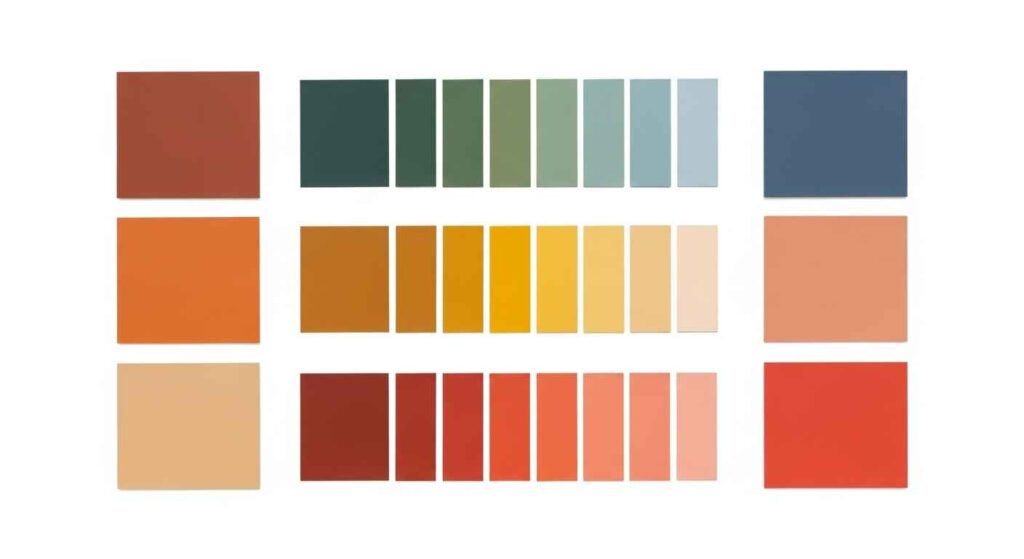
4. The Real Milk Paint Co. – Best Natural Option
Milk paint, made from organic milk protein, is a healthier alternative than water-based latex or oil-based paint used by many commercial options.
Key features:
- Made from organic milk protein
- 100% biodegradable
- 52+ color options
- Custom color blending available
- Works on wood, drywall, and concrete
Price: Around $70 per gallon
Best for: Furniture projects and rustic interior looks
5. Behr Premium Plus – Best Budget Option
Behr Premium Plus makes our list for its budget-friendly and low-to-no VOC paint selection. Both LEED and GREENGUARD GOLD certified, these paints are extremely durable while being friendly on your wallet.
Key features:
- Low to zero VOC options
- LEED and Greenguard Gold certified
- Stain and mold resistant
- 59+ color options
- Available at Home Depot
Price: Starting at $31 per gallon
Best for: Budget-conscious homeowners wanting certified safety
6. AFM Safecoat – Best for Sensitive Individuals
AFM Safecoat is dedicated to helping create healthy homes and environments through its medically approved building solutions. Each Safecoat recommended product is not only 100% VOC-free, but also completely free of HAPs (Hazardous Air Pollutants).
Key features:
- 100% VOC-free and HAP-free
- Medically approved formulations
- Nature-inspired color collections
- Three specialized paint lines
- 1,000+ color options
Price: Varies by retailer
Best for: People with allergies or chemical sensitivities
7. Backdrop – Best for Exterior Use
Backdrop spent a year curating 50 of the best colors for homes — and became the first climate-neutral paint company in 2020 along the way!
Key features:
- Low-VOC formulation
- Climate-neutral company
- Excellent exterior durability
- 82 curated colors
- Next-day delivery available
Price: Starting at $85 per gallon
Best for: Exterior projects and bold color choices
8. Graham & Brown – Best for Coordination
Graham & Brown makes it easy to coordinate your colors by offering eco-friendly wallpapers and paints to match. As a carbon-neutral company, the brand mixes your paints to order and plants trees to offset emissions.
Key features:
- Low-VOC water-based formula
- Carbon-neutral company
- 260+ color options
- Coordinating wallpapers available
- Custom mixing to order
Price: Starting at $70 per gallon
Best for: Complete room makeovers with coordinated elements
9. The Organic & Natural Paint Co. – Best Natural Ingredients
The Organic & Natural Paint Co. was founded back in 2012 to help raise awareness of the importance of air quality in the family home. Every single product (including their wood finishes) is VOC-free and uses natural raw ingredients in its formulation like clay.
Key features:
- VOC-free with natural clay ingredients
- Breathable paint formula
- 192 color options
- Suitable for genetic breathing conditions
- Interior and exterior use
Price: £79 per 4 liters (UK pricing)
Best for: Those wanting completely natural ingredients
Paint Finish Options for Eco-Friendly Paints
Different finishes serve different purposes in your home. Here’s how to choose:
Flat/Matte Finish
- Best for: Bedrooms, living rooms, ceilings
- Pros: Hides imperfections, low glare
- Cons: Harder to clean
Eggshell Finish
- Best for: Dining rooms, hallways
- Pros: Slight sheen, easier to clean than flat
- Cons: Shows imperfections more than flat
Satin Finish
- Best for: Kitchens, bathrooms, kids’ rooms
- Pros: Easy to clean, moisture resistant
- Cons: Can show brush strokes
Semi-Gloss Finish
- Best for: Trim, doors, cabinets
- Pros: Very easy to clean, durable
- Cons: Shows imperfections clearly
For more detailed information about choosing the right finish, check out our complete paint finish guide.
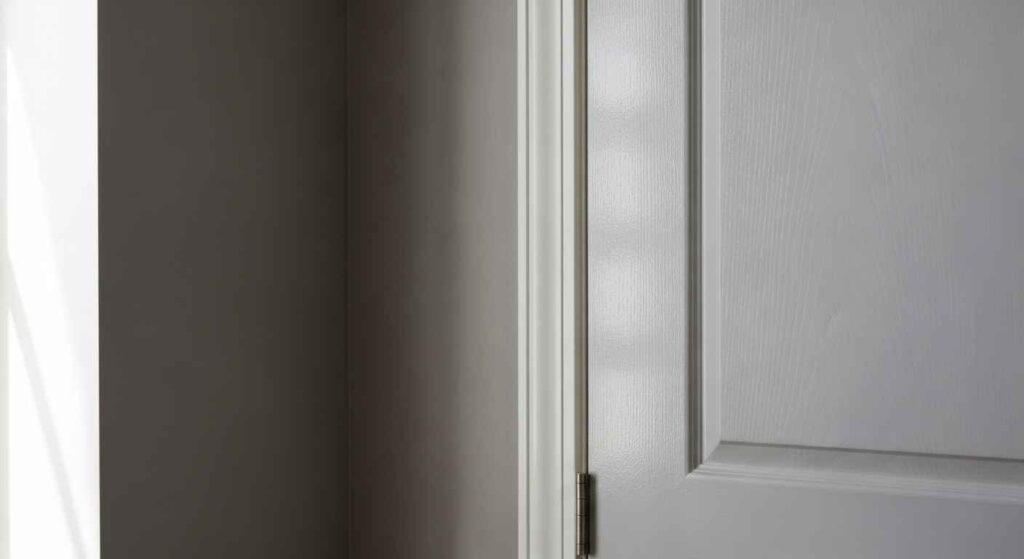
How to Choose the Right Eco-Friendly Paint
Consider these factors when selecting your paint:
1. Room Function
- High-traffic areas need durable, washable finishes
- Bedrooms can use flat finishes for comfort
- Bathrooms require moisture-resistant options
2. Family Health Needs
- Choose zero-VOC for nurseries and children’s rooms
- Consider milk paint for severe chemical sensitivities
- Look for allergen certifications
3. Coverage Requirements
Calculate square footage: (Length × Width) – door and window areas Most eco-friendly paints cover 350-400 square feet per gallon.
4. Color Preferences
- Test colors in your actual lighting conditions
- Order samples before committing to full gallons
- Consider how colors will look at different times of day
5. Budget Constraints
- Factor in primer costs (some paints include primer)
- Consider long-term durability vs. upfront cost
- Account for additional coats if needed
Application Tips for Best Results
Eco-friendly paints often require slightly different application techniques:
Preparation Steps
- Clean walls thoroughly with mild detergent
- Fill holes and sand smooth
- Prime if changing colors dramatically
- Use high-quality brushes and rollers
Application Techniques
- Apply thin, even coats
- Allow proper drying time between coats
- Maintain wet edge to avoid lap marks
- Work in natural light when possible
Tools Needed
- High-quality synthetic brushes
- Microfiber rollers for smooth finishes
- Painter’s tape
- Drop cloths
- Paint trays with liners
For effective cleaning and maintenance after painting, our microfiber cleaning guide offers helpful tips.
Cost Comparison: Eco-Friendly vs Traditional Paint
| Paint Type | Cost per Gallon | Coverage | Long-term Value |
|---|---|---|---|
| Traditional Paint | $25-45 | 350-400 sq ft | Lower (more frequent repainting) |
| Low-VOC Paint | $35-60 | 350-400 sq ft | Medium |
| Zero-VOC Paint | $50-90 | 350-560 sq ft | Higher (better durability) |
While eco-friendly paints cost more upfront, they often provide:
- Better coverage per gallon
- Longer-lasting finish
- Reduced health costs
- Higher home value
Common Mistakes to Avoid
1. Skipping Primer
Even with paint-and-primer combinations, separate primer may be needed for:
- Dark to light color changes
- Stained surfaces
- Previously unpainted surfaces
2. Poor Ventilation
Even zero-VOC paints benefit from good air circulation during application and drying.
3. Rushing the Process
Allow full cure time (usually 30 days) before assessing final color and durability.
4. Ignoring Temperature and Humidity
Apply paint when temperature is 50-85°F with humidity below 85%.
5. Using Low-Quality Tools
Cheap brushes and rollers can affect finish quality and paint performance.
Environmental Impact of Paint Choices
Your paint choice affects the environment in multiple ways:
Manufacturing Impact
- Traditional paints require petroleum-based ingredients
- Eco-friendly paints use renewable or recycled materials
- Local manufacturing reduces transportation emissions
Indoor Air Quality
- Zero-VOC paints improve indoor air quality immediately
- Better air quality reduces need for air purifiers
- Healthier indoor environment supports well-being
Waste Reduction
- Many eco-friendly brands use recycled packaging
- Water-based formulas are easier to dispose of safely
- Longer-lasting finishes reduce repainting frequency
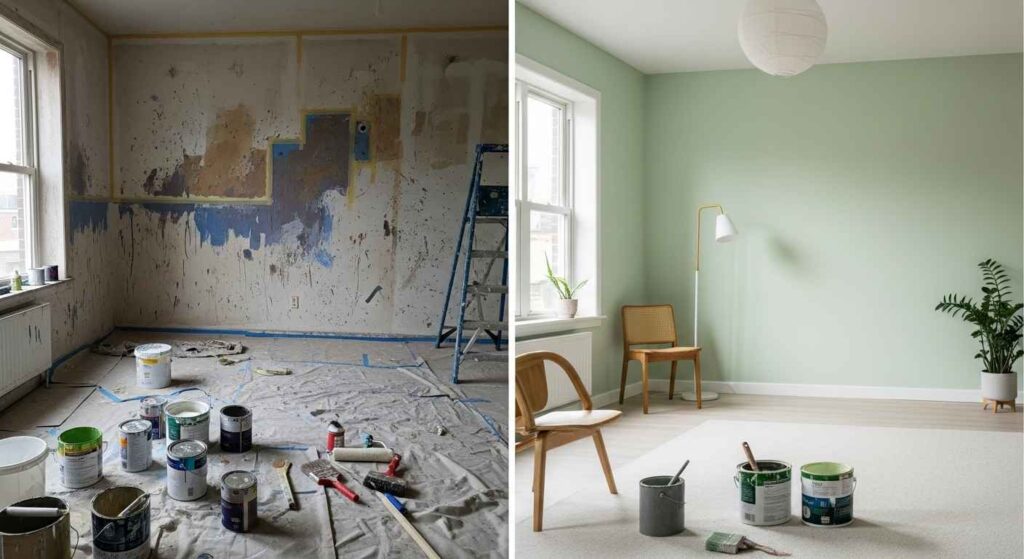
Special Considerations for Different Rooms
Kitchens
- Choose stain-resistant finishes
- Consider anti-microbial properties
- Use semi-gloss for easy cleaning
Bathrooms
- Select moisture-resistant formulations
- Ensure good ventilation during application
- Consider mold-resistant additives
Children’s Rooms
- Always use zero-VOC paints
- Choose durable finishes for active kids
- Consider fun, washable colors
Bedrooms
- Prioritize air quality with zero-VOC options
- Use calming colors that promote rest
- Consider flat finishes for comfort
For more room-specific decorating ideas, our color psychology guide explains how colors affect mood and well-being.
Maintenance and Longevity
Proper maintenance extends your eco-friendly paint job:
Regular Cleaning
- Use mild soap and water
- Avoid harsh chemicals that can damage finish
- Clean spills immediately
Touch-Up Strategy
- Keep paint for future touch-ups
- Label cans with room and date
- Store properly in cool, dry location
When to Repaint
- Visible wear or damage
- Color fading from sun exposure
- Lifestyle changes requiring different durability
Future Trends in Eco-Friendly Paint
The paint industry continues moving toward healthier options:
Emerging Technologies
- Air-purifying paint additives
- Recycled plastic-based formulations
- Plant-based pigments
Market Developments
- More zero-VOC options from major brands
- Improved durability in eco-friendly formulas
- Better color matching technology
Consumer Demands
- Increased transparency in ingredients
- More natural color options
- Packaging improvements
Conclusion
Choosing eco-friendly paint protects your family’s health while delivering beautiful, long-lasting results. The initial higher cost pays dividends through better indoor air quality, improved durability, and reduced environmental impact.
Start with zero-VOC options for bedrooms and nurseries, then expand to other areas as you renovate. With proper selection and application, eco-friendly paints provide the same stunning results as traditional options without the health risks.
Whether you choose premium brands like ECOS for maximum safety or budget options like Behr for affordability, any eco-friendly paint is better than conventional alternatives. Your family and the environment will thank you for making the healthier choice.
Ready to start your next project? Consider pairing your new paint with our accent wall design ideas or learn about textured painting techniques for added visual interest.
Quick Reference Checklist:
- ✓ Choose zero-VOC for bedrooms and children’s rooms
- ✓ Select appropriate finish for room function
- ✓ Calculate coverage needs accurately
- ✓ Test colors in actual room lighting
- ✓ Use high-quality application tools
- ✓ Allow proper curing time
- ✓ Maintain good ventilation during application
